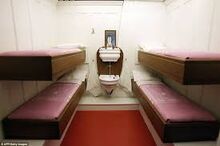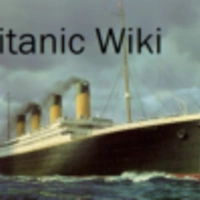m (returned to early format) Tag: Visual edit |
(Normal No changes) Tag: Visual edit |
||
| (5 intermediate revisions by 4 users not shown) | |||
| Line 1: | Line 1: | ||
{{Infobox_Room|name = Third Class cabins|deck = [[D Deck]], [[E Deck]], [[F Deck]], [[G Deck]]|class = 3rd-class|purpose = Passenger sleeping accommodations}} |
{{Infobox_Room|name = Third Class cabins|deck = [[D Deck]], [[E Deck]], [[F Deck]], [[G Deck]]|class = 3rd-class|purpose = Passenger sleeping accommodations}} |
||
| − | Third Class cabins were cabins that were for [[Third Class]] passengers. Most of them were located on [[F Deck]], with a few on the forward [[G Deck]]. They were noticeably less comfortable and spacious then their First and Second-class counterparts, which were located in higher decks. This area was the first to flood during the sinking, because of their location in the lowest decks in the bow. |
+ | Third Class cabins were cabins that were for [[Third Class]] passengers. Most of them were located on [[F Deck]], with a few on the forward [[G Deck]]. They were noticeably less comfortable and spacious then their First and Second-class counterparts, which were located in higher decks. This area was the first to flood during the sinking, because of their location in the lowest decks in the bow. |
== Accomodation == |
== Accomodation == |
||
| Line 8: | Line 8: | ||
Accommodation for Third-class was located in the least desirable parts of the ship, where passengers were subject to the noise and vibrations of the engines. These were on the lower decks at either end of the ship. Single men were housed in the bow while single women and families were accommodated in the stern section, with families occupying the larger cabins. Cabins were spacious by the standards of the time but often irregularly shaped, to conform with the curvature of the ship's stern and bow sections. Third-class cabins were very similar to Second-class ones in price and appearance; the only major differences were the lack of a wardrobe and a different style of washbasin. They were paneled in white-painted pine with salmon pink colored linoleum floors, furnished with plumbed-in washbasins, mattresses and White Star bed linens (the only exception was single men, who were provided with only straw-stuffed mattresses and a blanket). In contrast to First and Second-class, there were only two baths to serve the more than 700 steerage passengers on board at any one time. |
Accommodation for Third-class was located in the least desirable parts of the ship, where passengers were subject to the noise and vibrations of the engines. These were on the lower decks at either end of the ship. Single men were housed in the bow while single women and families were accommodated in the stern section, with families occupying the larger cabins. Cabins were spacious by the standards of the time but often irregularly shaped, to conform with the curvature of the ship's stern and bow sections. Third-class cabins were very similar to Second-class ones in price and appearance; the only major differences were the lack of a wardrobe and a different style of washbasin. They were paneled in white-painted pine with salmon pink colored linoleum floors, furnished with plumbed-in washbasins, mattresses and White Star bed linens (the only exception was single men, who were provided with only straw-stuffed mattresses and a blanket). In contrast to First and Second-class, there were only two baths to serve the more than 700 steerage passengers on board at any one time. |
||
| + | == Decks == |
||
| − | [[File:Titanic flooded bow.png|thumb|220x220px|Titanic's bow section in the early hours of the sinking. Notice how the lower third-class decks are already underwater.]] |
||
| + | * On D Deck, there were a few cabins at the very rear of the ship. |
||
| − | [[File:Third class.jpeg|thumb|220x220px|A usual third-class cabin.]] |
||
| + | * On E Deck, there were a few cabins at the forward end of Scotland Road and some near the seamen's bunks. There were more 3rd class cabins on the port side of the 2nd-class aft staircase and aft of that. |
||
| + | * On F Deck, there were cabins aft of the NO. 1 hatch and forward of NO.5 Boiler Casing. There were more 3rd class cabins at the aft end of F Deck. |
||
| + | * On G Deck, there were cabins between the NO.1 and NO.2 hatches. Also, there was a small group of cabins adjacent to the squash court on the port side. There were alternate 2nd/3rd class cabins situated around the NO.5 hatch but it was considered to be 3rd class and there were more 3rd class cabins situated around NO.6 hatch. |
||
| + | |||
| + | == Flooding == |
||
| + | |||
| + | [[File:Titanic flooded bow.png|thumb|220x220px|Titanic's bow section in the early hours of the sinking. Notice how the lower third-class decks are already underwater.]]G Deck flooded within 5-10 minutes after the iceberg collision, and F-deck flooded shortly after. Third Class passengers were the majority of the deaths in the sinking, because they didn't have much time to escape their staterooms. Another factor was that the staircases were located relatively far from the forward Third Class cabins, which was highly detrimental for the Third class passengers survival aspects.[[File:Third class.jpeg|thumb|220x220px|A usual third-class cabin.]] |
||
[[Category:Locations on board]] |
[[Category:Locations on board]] |
||
Revision as of 15:09, 15 April 2020
Third Class cabins were cabins that were for Third Class passengers. Most of them were located on F Deck, with a few on the forward G Deck. They were noticeably less comfortable and spacious then their First and Second-class counterparts, which were located in higher decks. This area was the first to flood during the sinking, because of their location in the lowest decks in the bow.
Accomodation
Third Class on board Titanic was noticeably more comfortable than what was offered on many of her competitors, though Third-class passengers enjoyed the smallest proportion of space on board and very few facilities. The White Star Line had earned a reputation for providing notably good service in Third-class, which was becoming an increasingly profitable share of the transatlantic passenger service. Technically "Steerage", the term for low-paying immigrant passengers housed in open-space dormitories, does not apply to the Titanic's Third-class passengers, all of whom were housed in private cabins of no more than 10 people. There were 84 two-berth cabins for the Third-class, and in all, 1,100 Third-class passengers could be accommodated.
Accommodation for Third-class was located in the least desirable parts of the ship, where passengers were subject to the noise and vibrations of the engines. These were on the lower decks at either end of the ship. Single men were housed in the bow while single women and families were accommodated in the stern section, with families occupying the larger cabins. Cabins were spacious by the standards of the time but often irregularly shaped, to conform with the curvature of the ship's stern and bow sections. Third-class cabins were very similar to Second-class ones in price and appearance; the only major differences were the lack of a wardrobe and a different style of washbasin. They were paneled in white-painted pine with salmon pink colored linoleum floors, furnished with plumbed-in washbasins, mattresses and White Star bed linens (the only exception was single men, who were provided with only straw-stuffed mattresses and a blanket). In contrast to First and Second-class, there were only two baths to serve the more than 700 steerage passengers on board at any one time.
Decks
- On D Deck, there were a few cabins at the very rear of the ship.
- On E Deck, there were a few cabins at the forward end of Scotland Road and some near the seamen's bunks. There were more 3rd class cabins on the port side of the 2nd-class aft staircase and aft of that.
- On F Deck, there were cabins aft of the NO. 1 hatch and forward of NO.5 Boiler Casing. There were more 3rd class cabins at the aft end of F Deck.
- On G Deck, there were cabins between the NO.1 and NO.2 hatches. Also, there was a small group of cabins adjacent to the squash court on the port side. There were alternate 2nd/3rd class cabins situated around the NO.5 hatch but it was considered to be 3rd class and there were more 3rd class cabins situated around NO.6 hatch.
Flooding

Titanic's bow section in the early hours of the sinking. Notice how the lower third-class decks are already underwater.
G Deck flooded within 5-10 minutes after the iceberg collision, and F-deck flooded shortly after. Third Class passengers were the majority of the deaths in the sinking, because they didn't have much time to escape their staterooms. Another factor was that the staircases were located relatively far from the forward Third Class cabins, which was highly detrimental for the Third class passengers survival aspects.

A usual third-class cabin.
